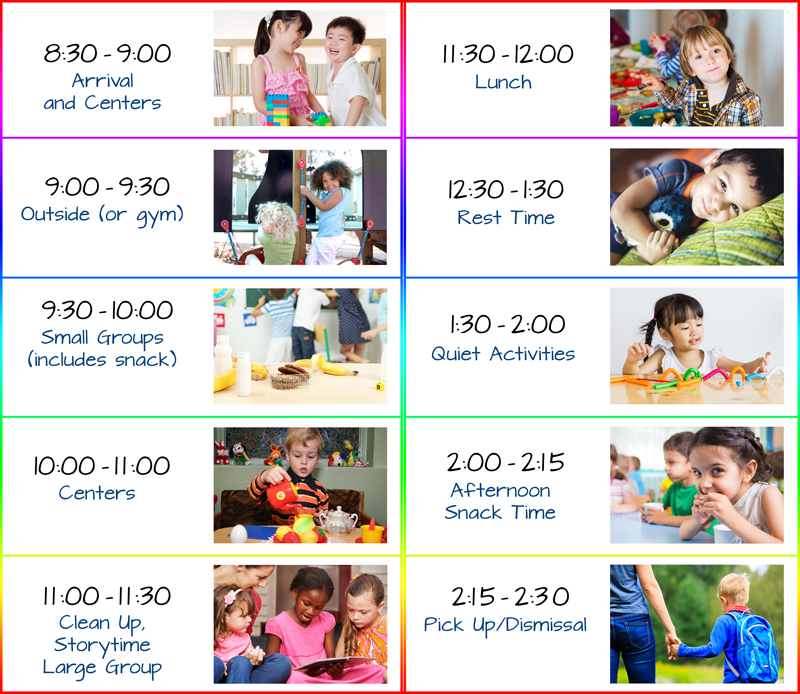What can teachers do to make the classroom environment more conducive to children’s learning and development?
Page 4: Temporal Environment
The term temporal environment refers to the timing, sequence, and length of routines and activities that take place throughout the school day. It includes the schedule of activities such as arrival, play time, meal time, rest time, both small- and large-group activities, and the many transitions that hold them all together. Predictable schedules and routines create a sense of security, help young children to learn about their world, help them to adjust to new situations, and prevent challenging behaviors. Daily routines also help young children to say good-bye to parents and to feel safe and secure within a nurturing network of caregivers. For example, establishing the routine of reading a book together every day in the same cozy corner of the room can help a child to prepare for the difficult separation from her parent.

The temporal design of the classroom environment is also dependent on the type of program, the length of the program, and the age of the children in the program. When designing the temporal environment, teachers should create schedules that meet the unique needs of their program, children, families, and staff. Teachers should also keep in mind that every group of children has its own personality; what worked well one year might not work well the next. In addition, teachers should think about each of the following. Click the items below to learn more.
Children need to have times to engage in high-energy activities as well as more quiet ones, and these should be alternated throughout the course of the day. Doing this is one way to help prevent challenging behaviors. For example, teachers might consider following a circle-time activity that involves a lot of sitting with one that allows more movement. Further, the amount of time children spend in any type of activity should be based on their age and developmental levels. When they schedule activities, teachers should:
- Make sure that children have frequent opportunities for movement. Teachers can embed short dance parties, stretching, or group exercise into their more sedentary activities.
- Use cool-down activities to help children to better transition between high-energy or exciting activities and lower-energy ones. For example, when children come in from outdoor play, they might be instructed to get a drink of water and sit with a book until the next activity begins.
Transitions are an essential part of every classroom schedule. Handled well, they provide children with the opportunity to be successful, manage their own materials, and demonstrate their capabilities. When managed poorly, however, they can become a time of chaos, increasing problem behavior and leading to greater stress for the teacher and children alike. Smooth transitions can appear almost effortless, but experienced teachers know they require planning and attention to detail. To create successful transitions, teachers can:
- Make sure to have clear signals for transitioning from one activity to another (e.g., give a two-minute warning, turn lights on and off, ring bell, sing a song).
- Establish rules about clean up (e.g., putting toys away at the end of free play center time).
- If possible, have a staff member available at each new activity to greet the children as they arrive. If this is not possible, make sure the children know what they should be doing.
- Be prepared for the children and be ready to begin the new activity as soon as they arrive.
- Consider what children do before they arrive in the classroom each morning. For example, children may have extended bus or car rides to school during which they have been required to sit. If the first activity is opening circle, these children might find it difficult to sit again for an extended period.
- Limit the amount of time children spend waiting in transition (e.g., in line) and limit the number of transitions children make during the day.
Children need to be taught the routines and schedules and what are they are expected to do during activities and during transitions. Clear expectations help children know how to participate in all classroom activities in a more meaningful way and decrease the likelihood of challenging behaviors. Specifically, teachers can:
- Post the schedule to help children and teachers be aware of it and use it.
- Teach the daily routines and schedules and review them throughout the day.
- Try to keep routines consistent, but prepare children for changes to the schedule should those changes become necessary. For example, on a rainy day remind the children that they will play indoors instead of outdoors.
- Develop schedules that are easy for children to understand (i.e., using simple language or visuals).
Abby Green shares how she has made transitions more effective for young children in her classroom (time: 1:30).

Abby Green-Taylor, MEd
Teacher III / KidTalk Coach
Susan Gray School
Vanderbilt University
Transcript: Abby Green-Taylor, MEd
One of the biggest things I did was adjust snack time because snack time was so early children weren’t wanting to go, and then they were asking for it later in the morning. Another one that I’ve really loved that we’ve starting doing the last two years is that we pretty much eliminate large-group transitions. We use small-group transitions so that we can ensure that all children have the support to transition successfully. So instead of all the children lining up at the door to go outside, these three children who are finishing up with morning meeting will start to clean up and start to get their jackets on. They have one teacher with them supporting them, so there’s never this giant rush to the door. It’s a big change from the typical way preschools use transitions in their schedules. It helps teach the children how to transition. Rather than already having the expectation that they know how to line up at the door, you teach the whole time. We’re walking down the hall together, and you can help them do it successfully if they’re not able to. I definitely use a two-minute warning pretty frequently. I have a little bell that I can play. If I don’t want everyone to know that in two more minutes some kids are going to go, I’ll just go to those individuals, and I’ll set a little sand timer, or I’ll introduce what their new choices are going to be. So I’ll say in two more minutes, art’s going to be finished, but these two new things are going to open up. Just introducing the transition slowly by letting them know what’s going to be happening.
Including Families
Different families have different routines. Asking families about their routines and schedules and trying to incorporate the ways that they care for their very young children creates cultural responsiveness and continuity between the program and home.
- Partner with families to create to a smooth transition for the child upon arrival and pick up from the classroom.
- Understand the expectations that families have at home for their child. For example, does the family require the child to sit at the table for the entire meal time or does the child leave as soon as he or she is done eating?
- Learn about the child’s activities at home (e.g., preferred activities, high-energy activities, daily routines).
- Share the classroom schedule and routines with families and be sure to communicate any changes.
Including Children with Disabilities
When they design the temporal environment, teachers should be aware that children with disabilities might require some additional considerations to fully participate in all the scheduled routines and activities. For these children, teachers can:
- Provide picture schedules for children who need visual reminders of the sequence of activities.
- Be flexible with the schedule and allow more time to complete transitions and activities for children who need it (e.g., those with motor impairments or developmental delays).
- Understand that students with medical conditions or physical impairments might have less stamina and tire more easily across the day. Teachers need to adjust their schedules accordingly to include these children in as many of the scheduled activities as possible. For example, some children will lack the stamina to fully take part in afternoon outdoor play, a high-energy activity. For these children, the teacher can plan a structured activity that requires less energy but still allows them to be included (e.g., tossing a large ball back and forth, throwing beanbags at a target).
- Pair children up to help each other during transitions.
- Allow for breaks and flexible lengths of participation.
- Partner with families to better understand the individual scheduling needs and routines of children with disabilities.
Ilene Schwartz illustrates why visual supports help children with disabilities be successful in early childhood settings (time: 2:13).
Ilene Schwartz, PhD
Professor, Special Education
Director, Haring Center for Research and Training in Inclusive Education
University of Washington

Transcript: Ilene Schwartz, PhD
One type of support that we use in the classroom a lot to help children with disabilities to be successful are visual supports. Visual supports can range from pictures to symbols to words to photographs to anything that helps make the expectation more clear. They help to make the abstract more concrete. What exactly is it that we expect the child to do. So we can have a visual support that tells the child the steps of a transition; it might be hang up your coat, hang up your backpack, get a book, come to circle. And there may be four steps on a schedule that we give a child with a disability to help them be more successful.
Another thing we do with visual supports is help children with disabilities understand how to use some of the materials in the classroom. For example, in the dramatic play area we may have some play scripts with simple pictures of how to play with the baby dolls: First you pick up the baby then you feed the baby then you give the baby a bath then you put the baby to bed. And there may be pictures to illustrate every step of that chain, every step of that process for the child with disabilities. You can use that same strategy in the block area. So if I have a child with a disability who’s not very skilled with block building, I can have pictures of block structures that are there for them to imitate. I provide the models for visual support so that there’s extra support embedded within the physical environment of the classroom. We can ensure that every child has a schedule so that they know what the expectations are, they know what’s happening next, they know what to expect, and they know what’s required to be successful in that environment.
Research Shows
DEC’s Recommended Practices note that environments should “provide opportunities for movement and regular physical activity to maintain or improve fitness and wellness.” Research shows that children in the United States need plenty of access to high-energy activities within the classroom schedule and daily routine:
- Obesity rates among preschoolers ages two to five have doubled in the past four decades.
- One in five children are overweight or obese by the time they reach their sixth birthday.
- Over half of obese children first become overweight at or before age two.
- Preschool children spend over four hours a day watching television and videos, including time in childcare.
(Solving the Problem of Childhood Obesity Within a Generation: A Report from the Childhood Obesity Task Force, 2010)
Additional Considerations for Infants and Young Toddlers
 Generally, with infants and young toddlers, it is important for teachers to focus on the sequence of the routines. For these very young children, it is even more important that teachers offer a predictable sequence of routines each day rather than keep to a strict schedule. More specifically, teachers should focus on the order in which things happen and allow children to set the pace. The schedules and routines must be based on the unique needs of each child within the group care setting. Routines develop naturally when teachers follow the child’s lead. For example, if a child is crying and obviously hungry, she should be fed and not have to wait for a set time. The same would hold true for napping. If an infant is tired, he should be allowed to sleep for as long as needed.
Generally, with infants and young toddlers, it is important for teachers to focus on the sequence of the routines. For these very young children, it is even more important that teachers offer a predictable sequence of routines each day rather than keep to a strict schedule. More specifically, teachers should focus on the order in which things happen and allow children to set the pace. The schedules and routines must be based on the unique needs of each child within the group care setting. Routines develop naturally when teachers follow the child’s lead. For example, if a child is crying and obviously hungry, she should be fed and not have to wait for a set time. The same would hold true for napping. If an infant is tired, he should be allowed to sleep for as long as needed.
For Your Information
To help prevent problem behavior, when they create the temporal environment, teachers can:
- Allow young children to take a break from challenging activities when necessary and appropriate.
- Allow children to participate for variable lengths of time in a given activity based on their developmental needs. For example, a child new to the classroom might be permitted to leave circle time if she is unable to sit the entire time. Teachers should have quiet alternate activities available that are in close proximity to the group (e.g., working a puzzle at nearby table) with the goal of gradually increasing the time the child participates in circle time.
- Remind children of the schedule throughout the day.
- Create portable schedules that children can carry with them as visual reminders of the sequence of activities.
- Limit the amount of time and the number of transitions across the day and even the transitions that can occur within activities such as circle time (e.g., story is read, weather is checked, movement or musical activity occurs, attendance is taken, schedule is reviewed).
- Teach and practice what is expected of children during transitions.